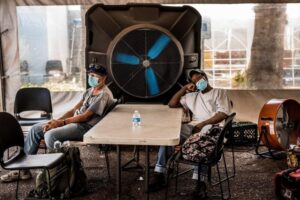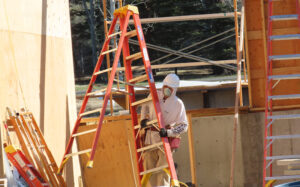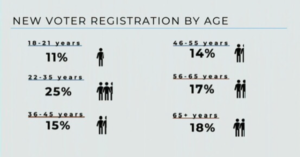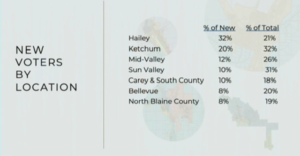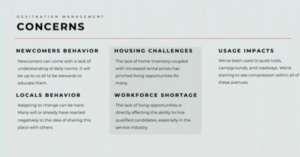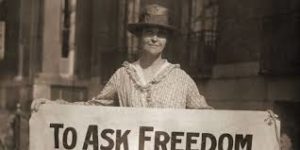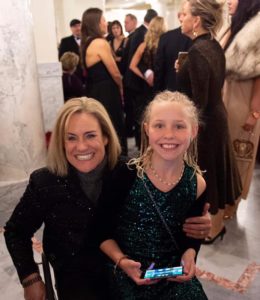Eye On Sun Valley
Are we paying attention?
May 18, 2021ProPublica updated this report from September, 2020. I missed it the first time published, and now already seeing population shifts in the Mountain West, specifically, the Wood River Valley in South-Central Idaho. -dayle
This article, the second in a series on global migration caused by climate change, is a result of a partnership between ProPublica and The New York Times Magazine, with support from the Pulitzer Center.
Senior citizens at a cooling center in Phoenix [summer 2020] during Arizona’s record-setting heat wave. (Meridith Kohut for The New York Times)
Climate Change Will Force a New American Migration
“Wildfires rage in the West. Hurricanes batter the East. Droughts and floods wreak damage throughout the nation. Life has become increasingly untenable in the hardest-hit areas, but if the people there move, where will everyone go?
The millions of people moving north will mostly head to the cities of the Northeast and Northwest, which will see their populations grow by roughly 10%, according to one model. Once-chilly places like Minnesota and Michigan and Vermont will become more temperate, verdant and inviting. Vast regions will prosper; just as Hsiang’s research forecast that Southern counties could see a tenth of their economy dry up, he projects that others as far as North Dakota and Minnesota will enjoy a corresponding expansion. Cities like Detroit; Rochester, New York; Buffalo and Milwaukee will see a renaissance, with their excess capacity in infrastructure, water supplies and highways once again put to good use. One day, it’s possible that a high-speed rail line could race across the Dakotas, through Idaho’s up-and-coming wine country and the country’s new breadbasket along the Canadian border, to the megalopolis of Seattle, which by then has nearly merged with Vancouver to its north.”
Sun Valley’s Population Explodes During Pandemic Year
Eye on Sun Valley
|
https://eyeonsunvalley.com/Mobile/Mobile_Story_Reader?StoryId=8355
Idaho Mountain Express
by Greg Foley
Sun Valley tourism is rebounding, marketing group says
Report: Some 1,500 people have moved to valley during pandemic
The Sun Valley area is undergoing an unexpected surge in growth amid the COVID-19 pandemic, changing life for locals and—to some degree—how Idaho’s premier tourist destination is marketed to potential visitors.
That was the overarching message of a semi-annual meeting conducted by the Visit Sun Valley marketing and business organization livestreamed to viewers Wednesday from The Community Library in Ketchum.
Many people coming to the area are “COVID evacuees,” remote workers, adventurers and people who own second—or third—homes in the area, he said. Amid the pandemic, Visit Sun Valley has had to consider that visitors are booking trips later, staying longer and have been looking for things to do, as many events were canceled, he said. Group visits were down, hotel bookings were down and there have been fewer “traditional” vacations of families flying in for a week-long visit. Instead, more people have been driving to the Wood River Valley from places such as Salt Lake City, Boise and Twin Falls, he said.
“It just hasn’t been the same as it was historically,” Fortner said.
The organization sees a “pent-up demand” for travel, the return of many popular events, increased confidence in the safety of travel, a strong interest in mountain communities and strong commercial air service to the region all as encouraging factors for the tourism sector, Fortner said. In addition, many people are conducting internet searches for Sun Valley, he noted.
As the organization moves into a new phase of its “Mindfulness in the Mountains” marketing campaign, it is encouraging community “stewardship” from visitors—people who are a “better visitor that is enlightened and informed,” the organization’s presentation stated.
In addition, Visit Sun Valley is promoting a wide range of “guided experiences”—including cooking classes, yoga, fly fishing and mountain biking—that educate visitors, get them outdoors and allow them to gain a “deeper sense of what Sun Valley is all about,” said Marketing Director Ray Gadd. Visit Sun Valley is also promoting the return of signature events, including the Sun Valley Music Festival, the Sun Valley Writers’ Conference and the Trailing of the Sheep Festival, Gadd said.
During the meeting, David Patrie, outreach director for the Sun Valley Economic Development business organization, presented data from an in-depth analysis of the effects of the pandemic and an influx of new residents into the Wood River Valley over the past year.
“Last March, we never would have predicted where we are today,” Patrie said.
New voter registrations in Blaine County increased from 1,640 in 2016 to 3,770 in 2020, Patrie said, with most registrants in the 22-35 age range.
“Yeah, it’s a lot,” he said, “and it feels like a lot.”
Are you tired?
August 21, 2020Me, too. Exhausted.
Everyday endless push notifications reminding us that We the People are getting close to falling off the existential cliff that is our American experiment.
We can’t look away from any of it.
CNN:
Joe Biden’s campaign and the DNC raised $70 million during the convention.
— 122M people watched, including 35M streams. Another 128M views across Biden/convention social
— 1.1 million people texted 30330
— 700K uniques on IWillVote
We can do this. YOU can do this.
Our latest institution to be attacked and depleted is the United States Postal Service. This one must hold our focus beyond the explosive 24 hour news cycle.
Make a plan. Request an absentee ballot now. And vote early.
Eye On Sun Valley
Voting Options Questioned Due to Post Office Chaos, Pandemic
by Karen Bossick
How to vote?
That’s the all-consuming question with just 77 days left until the 2020 November election.
The U.S. Postal Service has warned that it may not be able to get ballots to election offices in time because of lags in mail delivery. And it’s anyone’s guess at this point whether Wood River Valley residents will be able to vote in-person.
The Blaine County Election Office will begin early voting at the courthouse on Tuesday, Oct. 13, provided the county is not seeing a surge in coronavirus that would cause the office to be closed to the public.
Hailey Postmaster Ken Quigley has been praised by those at Blaine County’s Election Office for going out of his way to gather ballots by hand and deliver them to the Election office as deadlines approach.
This is what it’s going to take as voter suppression continues, all of us to do what we can to protect votes.
Postmaster General Louis DeJoy has reportedly removed mail processing equipment, eliminated overtime and slowed some mail delivery. DeJoy, who is reported to have financial stakes with competitors of the U.S. Post Office, has been accused of trying to handicap the Post Service to hinder mail-in voting.
The Guardian: DeJoy, conceded on Friday [August 21] he had implemented recent changes that led to mail delays at the USPS but said he would not reverse the decision to remove mail equipment ahead of the election.
DeJoy has moved to the top of the deplorable list, and while the Senate remains silent & Congress cries foul…and does nothing…We the People know what we have to do and encourage everyone in our communities to do:
V O T E
Dayle’s Community Cafe started posting about the post office and the GOP plot to diminish and privatize our sacred institution.
Before they declared their independence, the American colonists decided that they needed a better way to communicate with one another. In the summer of 1775, at the Second Continental Congress, they created the Postal Service and named Benjamin Franklin its first Postmaster General. Where before letters or packages had to be carried between inns and taverns or directly from house to house, now there was a way for Americans to safely, discreetly, and reliably correspond across long distances. After the Revolution, when Congress ratified the Articles of Confederation, legislators included the Post Office in the ninth of those articles, and later enshrined it in the first article of the Constitution.
The Founders saw the Postal Service as an essential vehicle for other rights, especially the freedom of the press: one of the first postal laws set a special discounted rate for newspapers. But they also understood that a national post unifies a nation, allowing its citizens to stay connected and connecting them with their federal government. When Alexis de Tocqueville toured the young country several decades after its founding, he travelled partly by mail coach, noting in “Democracy in America” how “the mail, that great link between minds, today penetrates into the heart of the wilderness.”
Senator Bernie Sanders was talking about re-establishing banking services at the post office to help lower income and Americans and strengthen the middle class. I had hopes about developing community communication centers at post offices, newspapers and local non-profit community radio stations. Instead, now we’re just trying to save the institution.
“Abraham Lincoln was U.S. postmaster and a storekeeper in the original version of this restored building in New Salem, Illinois.” -Historian Michael Beschloss
Senator Sanders: “We have a president who has admitted that he is trying to destroy the Postal Service to prevent people from voting. This election is about whether we retain our democracy. […] I stand with Danny Glover. We will not let Trump destroy a generational source of good, unionized jobs for Black Americans. We will save and expand the U.S. Postal Service—not privatize it.”
The founders were right to realize that the Postal Service isn’t only a way of moving thoughts and goods from every corner of America to any other, but also a way of uniting one of the largest and most diverse nations in the world. At a time when too few things connect us as a country, and too few of us have faith in our public institutions, we can’t afford to lose the one we trust the most. -Casey Cep, May 2020
Author Ari Berman:
USPS ordered to remove 671 mail sorting machines under DeJoy:
59 in Florida
58 in Texas
34 in Ohio
30 in Pennsylvania
26 in Michigan
15 in North Carolina
12 in Virginia
12 in Wisconsin
11 in Georgia
Really, how did we get here?
Maybe, collectively, what we’ve realized is that democracy is fragile and progress is not permanent. And 44 million people can not choose not to vote…like in 2016.
Michelle Obama:
“We have got to grab our comfortable shoes, put on our masks, pack a brown bag dinner and maybe breakfast too because we’ve got to be willing to stand in line all night if we have to.”
“What I’m seeing is very scary in our emergency department.”
April 2, 2020ER Doctor Issues Dire Warning
EYE ON SUN VALLEY
By Karen Bossick
‘Everyone needs to avoid contact with everyone outside their household or we’re not going to stop this thing.
“What I’m seeing is very scary in our emergency department, and that is volumes of patients who are very ill and who we’ve had to admit. Last weekend we admitted four patients in one hour,” Dr. Jim Torres told Dr. Tommy Ahlquist on Ahlquist’s Inspire Excellence podcast this week.
Torres said the beds at St. Luke’s Magic Valley hospital in Twin Falls are being filled up with patients from the Wood River Valley.
“And, if you can imagine, they get their own cases, and Boise gets their own cases filling up the ICUs with sick patients. Then, you know, they potentially could run out of beds, could run out of ICU beds, could run out of ventilators, and then we can get into the crisis mode where New York City is and some of these other big cities. It could happen here.”’
“You can look really well and have this virus and be giving it to other people who aren’t going to do so well… And there it goes,” he added. “You give it to one person. That person gives it to another person and so on and so on and so on. And that’s what’s happened here in our town.”
“It would be a nightmare if Twin and Boise started getting the number of cases Blaine County is seeing because there are so many more people in those towns, he said.
“And a lot more people who could be exposed and who could become ill. That would be a disaster.”
Torres’ plea comes at a time when Ketchum Fire Chief is pleading for volunteers—ski patrollers or others—to drive ambulances. Torres’ stable of paid staff members and volunteers has been decimated due to the coronavirus. The fire department has even borrowed ambulances from the City of Carey and elsewhere to keep up with the demand.
The number of cases in Ada County where Boise sits has climbed past Blaine County’s in the past few days.
Idaho reported 672 cases on Wednesday. It was the largest single-day increase, up from 527 the day before.
Despite the growing numbers in Blaine County, several Eye on Sun Valley readers reported Wednesday that the traffic through Ketchum seems to have grown, not lessened. And supermarkets are bustling.
“No spacing between people as they come in, and I was told that some people come in every day,” said one woman.
“That’s why so many people are still coming down with it. No one is paying attention to the social isolation order. They don’t think they will get it, either because they are younger or they still think it’s a hoax. Someone needs to get word to them to stop. It’s just awful.”
Another woman said she was out on a daily walk near Knob Hill Park when she saw several teens and young adults gathered there.
“I considered going up and talking to them about the importance of social distancing, but I didn’t know them and felt uncertain of my welcome,” she said. “How do we educate kids about this and what can happen if they bring it home to their families or others.”
https://eyeonsunvalley.com/Story_Reader/7108/ER-Doctor-Issues-Dire-Warning/
100 Years.
March 12, 2020The local celebration actually started during Hailey’s Fourth of July Parade.
#WomenVote
STORY AND PHOTO BY KAREN BOSSICK
‘The Idaho Women’s 100 Kickoff Event will take place at noon Friday, March 13, in downtown Hailey. Another will take place in Ketchum at the same time.
The event commemorates the 100th anniversary of the passing of the 19th Amendment to the U.S. Constitution, giving most women in America the right to vote.
The Ketchum event will start at noon at Ketchum Town Square.
Hailey’s event will also start at noon. Participants will gather in front of the Hailey Public Library and march to the Old County Courthouse where a Governor’s Proclamation celebrating Idaho Women’s Day will be read.
Speakers will also speak to the occasion.
At 12:30 p.m. participants will ring bells, including the large bell at Emmanuel Episcopal Church. The bell ringing is a symbolic gesture that unites all Idahoans in commemorating the right of women to vote.
“This is a big day for our country and for all the women who make it great,” said organizer Bob McLeod, president of the Blaine County Historical Museum. “We hope everyone takes a moment to join us in ringing a bell to celebrate.”
Numerous events commemorating the passage of the 19th Amendment will be held around the state during 2020, organized by the Idaho Women in Leadership and the Idaho State Historical Society. Among them exhibits on Idaho’s “First, First Family” and “Miss Fletcher’s Botany Expedition” in the Idaho State Capitol.
Questions? Call the library at 208-788-2036 or the museum at 208-788-1801.’
If you attend, please remember pandemic social distancing guidelines and keep three feet apart from each other. -dayle
https://eyeonsunvalley.com/Story_Reader/7037/Ring-a-Bell-to-Celebrate-Women’s-Right-to-Vote/
E qual R ights A mendment
February 13, 2020NPR
2.13.2020
‘The U.S. House has voted to remove the deadline on ratifying the Equal Rights Amendment in an attempt to revive the amendment. The 232-183 vote fell largely along party lines with five Republicans supporting the measure and zero Democrats opposing it.
Changing the deadline is a key part of one route that some ERA proponents believe would lead to the amendment becoming a part of the Constitution, but the path forward is uncertain.
The proposed amendment says simply, “Equality of rights under the law shall not be denied or abridged by the United States or by any state on account of sex,” and it has had a renaissance in recent years, with three states ratifying it since 2017.
However, the bill may well be stymied after this vote.
Senate Majority Leader Mitch McConnell, R-Ky., said earlier this month that he’s “personally not a supporter” of the amendment, and the Trump administration’s Office of Legal Counsel has said that it considers the ERA “expired.
The amendment, proposed in 1972, originally had a ratification deadline of 1979 attached to it. Congress later bumped that out to 1982, but by then, only 35 states had ratified it. Thirty-eight states need to ratify in order for a proposal to become an amendment.
Illinois and Nevada ratified the amendment in recent years, and in January, Virginia became the 38th state to ratify.
[Passed by Congress June 4, 1919, and ratified on August 18, 1920, the 19th amendment granted women the right to vote.]
“It’s not just about women; it’s about America,” said House Speaker Nancy Pelosi, D-Calif. “The ERA will strengthen America, unleashing the full power of women in our economy and upholding the value of equality in our democracy.”
Legal experts have argued that the amendment could protect women economically, like helping them get more equal pay and preventing pregnancy discrimination.’
FX dropped the trailer for “Mrs. America,” its nine-episode limited series starring Cate Blanchett as Phyllis Schlafly. If you didn’t know that the real-life Schlafly didn’t support the women’s liberation movement, you certainly will after watching this.
You can watch the two-minute, 16-second clip above and see just how deep Phyllis’ complex relationship with the attempts to ratify the Equal Rights Amendment goes.
The show, one of the first “FX on Hulu” series, will launch its first three episodes Wednesday, April 15 on FX’s streaming hub on Hulu, with new episodes airing each subsequent week on the platform.
Along with Blanchett, “Mrs. America” stars Rose Byrne as Gloria Steinem, Margo Martindale as Bella Abzug, Uzo Aduba as Shirley Chisholm, Elizabeth Banks as Jill Ruckelshaus and Tracey Ullman as Betty Friedan. Other cast members include Sarah Paulson, John Slattery, Jeanne Tripplehorn, Ari Graynor, Melanie Lynskey and Kayli Carter.
Here’s the official description for the series:
“Mrs. America” tells the story of the movement to ratify the Equal Rights Amendment (ERA), and the unexpected backlash led by a conservative woman named Phyllis Schlafly, played by Blanchett. Through the eyes of the women of that era – both Schlafly and second wave feminists Gloria Steinem, Betty Friedan, Shirley Chisholm, Bella Abzug and Jill Ruckelshaus – the series explores how one of the toughest battlegrounds in the culture wars of the 70s helped give rise to the Moral Majority and forever shifted our political landscape.
Matriarch v. Patriarch. Hofstede’s cultural dimensions theory: ‘femininity represents a preference for cooperation, modesty, caring for the weak, and quality of life…masculinity, heroism and material rewards.’
“Conversations with Exceptional Women”
Annual Conference with the Alturas Institute
Friday, September 10th & 11th, 2020
Community Library in Ketchum
‘Conversations with Exceptional Women is The Alturas Institute’s signature event for the promotion of gender equality. We gather women from across the nation, from various sectors, disciplines and industries to engage in relaxed, casual and stimulating conversations about issues confronting women and the world. Our speakers have included Supreme Court Justices, Nobel and Pulitzer prize-winning recipients, astronauts, award-winning journalists, writers and academics, and acclaimed film directors, producers and actors, as well as Olympic Gold Medalists, corporate leaders and government officials. This year’s theme, “The Higher Ground,” affords our speakers a platform to discuss personal and professional pursuit of their dreams and aspirations, with an eye on the challenges and hurdles that have been overcome, and those that remain.”
When Wood River Valley women pencil in their votes on their ballots today, they will be taking part in a time-honored ritual that was only granted to women 100 years ago.
“We’ve traveled a long way in the last 100 years with 10 million more Americans becoming eligible to vote with the ratification of the 19th amendment in June 1919,” says Constitutional Scholar David Adler. “But why did it take so long? It’s because women were dealt their cards from the bottom of the deck.”
The centennial of the 19th amendment granting women the right to vote is near and dear to Adler’s heart.
He discussed the fascinating tale of how women got the vote–a story punctuated with intrigue–at a presentation at Ketchum’s Community Library. And he talked about it during the annual Conversations with Exceptional Women conference held by the Alturas Institute in September.
American women could not buy or sell property during the nation’s infancy. They were “under the cover” of their husbands, thanks to old English law.
“The thinking was that women didn’t need to speak for themselves—their husbands could,” Adler said. “A woman’s place was to have children and keep hearth and home. Politics were considered too dirty for fragile women.”
Women didn’t necessarily agree.
None other than Abigail Adams told her husband John, the second president of the United States, “Don’t forget the ladies,” as he headed out to craft a new nation at the Continental Congress.
He—and others—did forget, or dismiss, the ladies. And 70-some years later in 1848 women rallied to hold the first national convention to promote women’s rights at Seneca Falls, N.Y. “A few good men” also attended, including Frederick Douglass, the former slave-turned-abolitionist, noted Adler.
They penned something resembling the Declaration of Independence, saying that all men AND women are created equal and that women should have the right to vote.
That, too, was ignored by the men in power. But Susan B. Anthony managed to turn the tables when she convinced U.S. Sen. Aaron Sargent (R-Calif.) to introduce women’s suffrage to Congress during a long train ride from California to Washington, D.C., in 1872. But, again, white males had no interest in passing the Susan B. Anthony amendment when it was finally introduced in 1878.
Out west it was a different matter. The first territorial legislature of the Wyoming Territory granted women suffrage in 1869, with a Laramie woman becoming the first to cast a vote in September 1870. Colorado followed suit in 1893 and Utah and Idaho in 1896.
“The men outnumbered the women 2-1 in the state of Wyoming in the late 19th century. And they thought giving women the right to vote might attract more women to the state,” Adler said.
By the 1916 election, 16 states had given women the right to vote, prompting Woodrow Wilson to realize that he and others could be defeated if they did not support it.
In 1918 he delivered a speech noting that women had filled the jobs of men who had gone to war, their performance critical to the nation’s security, and so they deserved the right to vote. Moreover, he added, women—not men—had given birth to those serving in the army.
Congress passed the amendment but it needed 36 states to ratify it. With 35 states saying “Aye,” all eyes turned to Tennessee. as the only one left that could take a vote that year.
Connecticut, Vermont, North Carolina and Florida refused to consider the resolution. And the rest of the Deep South was entrenched against it.
The Tennessee governor called a special session and armies of suffragettes and anti-suffragette lobbyists invaded the Volunteer State. The War of the Roses erupted as lobbyists from Jack Daniels showed up, pouring plenty of liquid bribes against the amendment for fear women would continue prohibition if they got the right to vote.
In fact, bribes to vote against the amendment became so prolific that suffragettes were placed at railroad stations to turn back anyone approaching an amendment supporter with a suitcase.
“Those against felt the passage of the 14th amendment giving black Americans the right to vote had put them under the subjugation of blacks,” Adler said. “We will not let Tennessee be terrorized by women, especially black woman, they said. Let’s not let down our southern neighbors, they said. Women have a place—it’s in the home. If they vote who’s going o be at home to raise the children?”
At one point, the governor thought he had the vote only to have the speaker of the House change his mind after being offered the promise of governorship if he would keep the amendment from being passed.
On the eve of the vote, anti-suffragettes sent fake telegrams to amendment supporters telling them, they needed to return home because their wife or child was on their death beds.
When one amendment supporter received a telegram that his wife was dying, the House minority leader arranged for a wealthy man to charter a private train so the legislator could get home and, if his wife was okay, return in time for the vote.
When another received a telegram that his baby was dying, another private train was chartered for him so he could sneak out at night, rush home and rush back.
As the vote neared its conclusion, it was tied 48-48, despite lobbyists who had been allowed to come forward, Jack Daniels in hand and money in their pockets.
The tiebreaker was a 24-year-old named Harry Burns, who had been the youngest ever elected to the legislature.
He wore a red rose on his lapel signifying his opposition to ratifying the amendment. And he had voted against it twice during earlier roll calls.
But, when it came his time to vote this time, he blurted out a quick “Aye.” And with that the 70-year battle for suffrage came to a close
“In his suit pocket was a letter from his mother Febb E. Burn in which she asked him to ‘be a good boy’ and vote for the amendment,” Adler said. “She wrote, ‘As you know, I’m an advocate for the 19th amendment. I hope you will do the right thing and vote for America.’ ”
“I’m looking forward most to the day we get Medicaid Expansion up and running.”
January 7, 2019EYE ON SUN VALLEY
Karen Bossick
This year’s legislature will also be under the gun to try to improve the Department of Corrections, which sends a thousand inmates to Texas because Idaho prisons are busting at the seams. The Department of Corrections wants $500 million to build a new facility without doing anything about why it’s busting at the seams, Stennett said.
“If someone’s caught with small amount of marijuana, do we really want to spend tens of thousands of dollars to incarcerate them, while rendering them unproductive, rather than enroll them in a good drug program?” she (Sen. Michelle Stennett) asked.
Stennett also warned that many taxpayers may take a major hit on their tax bills this year because no one told them to change their W-4s what with personal and dependent exemptions being eliminated and most itemized deductions being eliminated or capped.
“There’s going to be a lot of outrage,” she predicted. “I’d suggest people go to Idaho State Tax Commission and find out how new tax structure will affect you.”
Stennett praised Blaine County for having the highest voter turnout in the state with 90 percent of registered voters going to the polls. Stennett noted that Democrats gained one seat in Senate, meaning seven of 35 senators are Democrat. They lost one Senate seat by 11 votes but gained three seats in the House.
“We went from 17 percent to 20 percent of the legislature. It doesn’t sound like much but I’ll take every bit of it,” she said.
Stennett said Blaine County residents can put themselves in any committee room via PBS livestream.
“But if you can, it’s can be powerful to be there in person,” she said. “The committee is where the real work done. And it’s where citizens can have their say. Once a bill hits the floor, you can be in the gallery. But you can’t say anything.”
Rep. Muffy Davis will serve on the Judiciary, Rules and Administration committee, as well as Transportation & Defense and Health & Welfare. Davis hopes to put out 2- to 5-minute videos every Friday before she comes home for the weekend.
“I’m looking forward most to the day we get Medicaid Expansion up and running,” she said. “That’s why I got into this to begin with.”
Contact:
Rep. Muffy Davis at mdavis@house.idaho.gov or call 208-332-1174.
Rep. Sally Toone at stoone@house.idaho.gov. Or, call 208-332-1032.
Sen. Michelle Stennett at mstennett@senate.idaho.gov or call 208-332-1353.
Rep. Muffy Davis and her daughter Elle at the Idaho Inaugural Ball.
